ORDER
Ciconiiformes
FAMILY
Ardeidae
GENUS & SPECIES
key features
• Unlike other herons, hunts by forming a canopy with its wings over the water to reduce glare and attract prey to the shade
• Entirely black except for its yellow-orange feet, which turn bright red during courtship
• Both parents incubate the eggs and care for the chicks until they are ready to leave the nest
where in the world?
Found in Africa, south of the Sahara, including Guinea, Ivory Coast, Nigeria, Kenya, Tanzania, Zambia, Zimbabwe and South Africa; also on the island of Madagascar
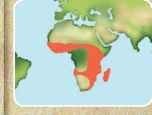
LIFECYCLE
The black heron employs an unusual hunting method: it spreads its wings like a cape, creating a shade canopy over the water’s surface that lures prey within striking distance.
HABITAT
The black heron is usually found near freshwater throughout its African habitat.This wading bird prefers shallow lakes, rivers, ponds, marshes, flood plains and rice paddies, as well as alkaline lakes, mangroves and tidal flats. The black heron has also been recorded as high as 4,900′ above sea level on the high plateaus of Madagascar.This sedentary bird remains within its home territory, where it roosts in tall trees at night and wades in shallow water or mudflats. Breeding grounds, also within the territory, are reused year after year.
CONSERVATION
The black heron is locally abundant in parts of its range, but is declining due to habitat destruction and overhunting.Though not globally threatened, it is often disturbed by human encroachment during breeding, and many colonies have a low breeding success.

A Group outing The black heron often forms flocks near shallow lakes and ponds.
BEHAVIOR
The black heron spends a great deal of time on the ground, walking on strong, unwebbed feet. At communal roosts, flocks mix with other species during feeding and rest periods. The black heron is generally quiet except during the breeding season; then, it emits a guttural call, usually during rainy months. When alarmed, the heron emits a low-pitched croak.
The black heron preens and grooms itself with its soft powder-down feathers. Using its bill to spread the powder onto its feathers, the black heron then uses the comblike claw on its longer middle toe to remove grease, dirt and fish slime from its plumage. Males and females often engage in mutual cleaning as part of the mating ritual; this serves to strengthen the bond between breeding pairs.
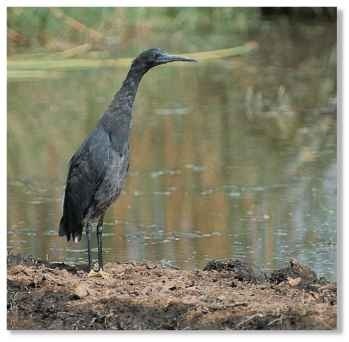
A Long-day’s journey The heron spends most of its day walking while searching for prey.
FOOD & FEEDING
The black heron feeds mainly on fish and employs a unique feeding technique — it lures prey to the surface of the water by forming a canopy with its wings. The black heron walks about slowly, intermittently spreading its wings over its head like an umbrella, maintaining this pose for 2-3 seconds. The canopy reduces glare and forms shade — this attracts fish, its favorite prey. The black heron spears a fish with its long, pointy bill, and swallows it whole, usually head first, to avoid the fish’s spiny fins. This bird also feeds on crustaceans and aquatic insects that it stirs up by raking its feet along the muddy bottom. The black heron feeds during the day or at dusk, and then moves off to nighttime communal roosts with other herons, egrets and darters.
BREEDING
Breeding occurs during the rains and flooding periods, and the male begins to collect nest materials while simultaneously trying to attract a female. Nests are usually scattered in colonies mixed with other herons, egrets or darters. Both sexes’ yellow-orange feet turn bright red during courtship.The male stretches on his perch, pointing his head and neck to the sky, inviting the female to take a closer look. After mating, the pair builds a nest of sticks and rocks in trees up to 15′ above ground, or in bushes or reed beds near or over water. Both sexes incubate for the 2-4 eggs for 18-30 days.The helpless and blind chicks are covered with a dark-gray down and hatch at different intervals over a one-week period; the adults feed them regurgitated food. Because of the hatching intervals, there is a big difference in the chicks’ size, and the largest chick often gets more food; some late-hatching chicks do not survive. Juveniles resemble adults but have duller plumage and reach maturity in 1-2 years.
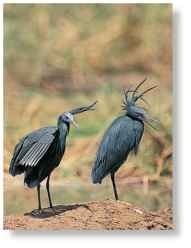
A Mates for life Like most herons, the black egret forms monogamous pair bonds.
In 1950, more than 10,000 black herons lived in a single colony at Antananarivo on the island
of Madagascar; today there are fewer than 50 pairs of birds there.
The black heron also forages by vibrating its colorful feet in the water; this helps to attract aquatic prey, such as fish and crustaceans.
cloak and dagger
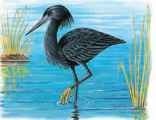
l Slow approach…
A black heron walks slowly through shallow wetland waters while scanning for prey, such as fish and crustaceans.
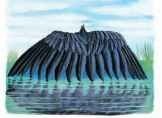
2 Cloaking…
The heron stops and holds its broad wings in a canopy. The wings come together at the tips, just above the water’s surface.
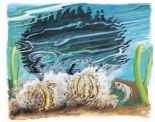
3 Setting the trap…
Lured by the false shade, a fish ventures close. The heron starts moving its feet, arousing the fish’s curiosity and bringing it closer

4 Caught
After impaling the fish, the heron pulls its head up and repositions the fish in its bill; like all herons, it swallows its prey whole.

PROFILE
Black Heron
The black heron’s yellow-orange feet turn a rich red during the breeding season; its broad wings are an integral part of its hunting technique.
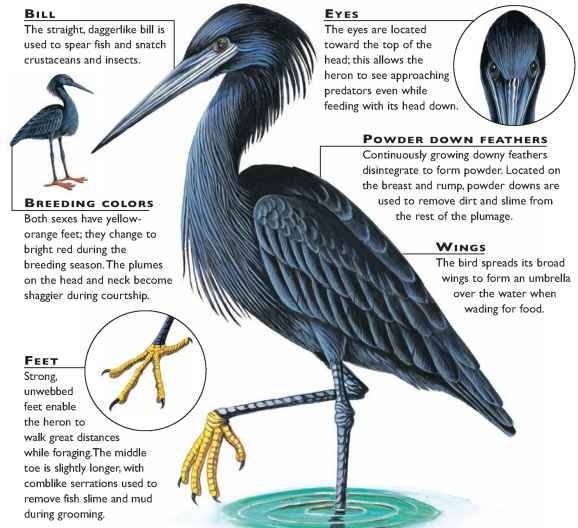
CREATURE COMPARISONS
The pied heron (Egretta picata) is smaller than the black heron, at 18-21″. Also black the pied heron also has white plumage, mostly or its neck. Like its cousin, the pied heron feeds on aquatic insects, crustaceans and fish, but its range is in New Guinea, Australia, Moluccas and Tanimbar Island, far removed from the black heron’s African home. Unlike its relative, the pied heron often uses aerial techniques to capture prey, whether pausing in midflight to capture prey or striking the surface of the water to flush out a victim. Nesting habits of the two species are similar; both breed in colonies and build untidy platform nests of sticks and twigs.
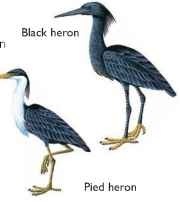
| vital statistics | |
| Weight | 9.5-14 oz. |
| Length | 16.5-26″ |
| Wingspan | 35-41″ |
| Sexual Maturity | 1-2 years |
| Breeding Season | Varies with location |
| Number of Eggs | 2-4 |
| Incubation Period | 18-30 days |
| Fledging Period | Unknown |
| Breeding Interval | 1 year |
| Typical Diet | Fish, crustaceans and aquatic insects |
| Lifespan | Unknown |
Related species
• The black heron is 1 of 13 species in the genus Egretta, which includes the great egret, E. alba, the little egret, E. garzetta and the white-faced heron, E. novaehollandiae. There are 60 species in 17 genera of heron, egret and bittern within the family Ardeidae. The goliath heron, Ardea goliath, is the largest heron, reaching nearly 5′ long with a massive wingspan of up to 7.5′.

